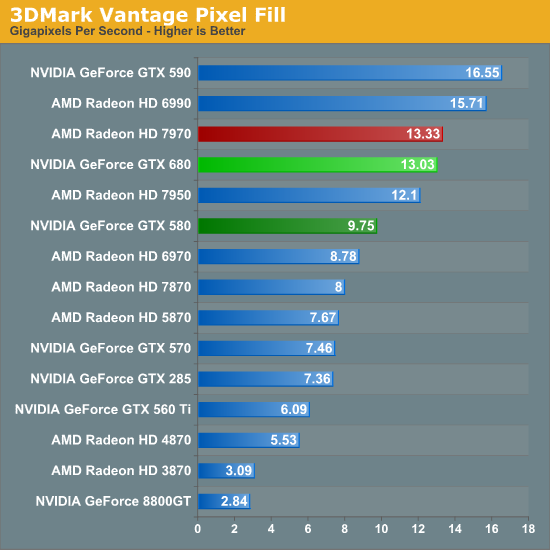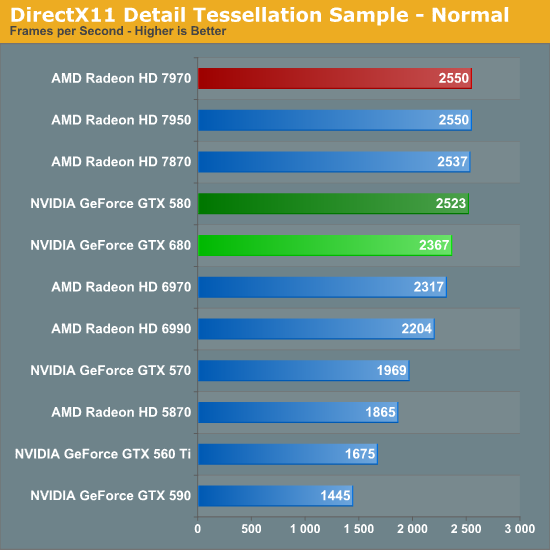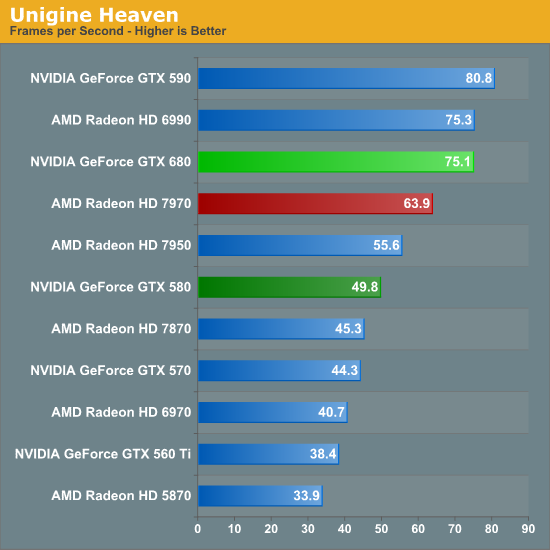NVIDIA GeForce GTX 680 Review: Retaking The Performance Crown
by Ryan Smith on March 22, 2012 9:00 AM ESTTheoreticals
As with any new architecture, we want to take a few moments to look at theoretical performance. These numbers shouldn’t be taken too seriously for cross-vendor comparison, but these numbers often tell us more about interesting architectural improvements that occur from one generation to the next.

Our first theoretical test is perhaps the most perplexing: 3DMark Vantage’s pixel fill test. Typically this test is memory bandwidth bound as the nature of the test has the ROPs pushing as many pixels as possible with as little overhead as possible, which in turn shifts the bottleneck to a mix of ROP performance and the memory bandwidth needed to feed those ROPs.
Compared to the GTX 580, the GTX 680 has almost exactly the same amount of memory bandwidth (192GB/sec) and only 86% of the theoretical ROP performance (37Gpix vs. 32Gpix). In short, it shouldn’t outperform the GTX 580 here, and yet it outperforms the 580 by 33%.
Why does it do this? That’s the hard thing to answer. As we mentioned in our look at GK104’s architecture, NVIDIA did make some minor incremental improvements to their ROPs coming from GF114, such as slightly improved compression and improved polygon merging. One of those may very well be the contributing factor, particularly the compression improvements since this is a typically memory bandwidth bottlenecked test. Alternatively, it’s interesting to note that the difference between the two video cards is almost identical to the difference in the core clock. GTX 560 Ti’s results tend to blow a hole in this theory, but it bears consideration.
In any case, it’s an interesting turn of events and hopefully one that isn’t simply an edge case. As we’ve seen in our benchmarks GTX 680 has strong performance – even if its lead compared to the 7970 diminishes with resolution – but compared to the GTX 580 in particular it needs strong ROP performance across all games in order to deliver good performance at high resolutions and anti-aliasing.

Our second theoretical test is 3DMark Vantage’s texture fill test, which to no surprise has the GTX 680 handily clobbering all prior NVIDIA cards. NVIDIA’s inclusion of 128 texture units on GK104 versus 64 on their previous generation GPUs gives the GTX 680 far better texturing performance. The 30%+ core clock difference only serves to further widen the gap.


Our third theoretical test is the set of settings we use with Microsoft’s Detail Tessellation sample program out of the DX11 SDK. Overall while NVIDIA didn’t make any significant changes to their tessellation hardware (peak triangle rate is still 4/cycle), they have been working on further improving performance at absurdly high tessellation factors. You can see some of this in action at the max factor setting, but even then we’re running into a general performance wall since the Detail Tessellation program can’t go to the absolute highest tessellation factors NVIDIA’s hardware supports.

Our final theoretical test is Unigine Heaven 2.5, a benchmark that straddles the line between a synthetic benchmark and a real-world benchmark as the engine is licensed but no notable DX11 games have been produced using it yet. In any case the Heaven benchmark is notable for its heavy use of tessellation, which means it’s largely a proxy test for tessellation performance. Here we can see the GTX 680 shoot well ahead of the GTX 580 – by more than we saw in the DX11 Detail Tessellation sample – but at the same time there’s a lot more going on in Heaven than just tessellation.
Honestly at this point in time I’m not sure just how much more tessellation performance is going to matter. Until DX11 is the baseline API for games, tessellation is still an add-on feature, which means it’s being used to add fine detail to specific models rather than being used on everything in a game world. This demands good tessellation at high factors but at the same time it’s subject to diminishing returns on the improvement to image quality as triangles reach single pixel sizes and smaller. To that end I’m still waiting to see the day where we see tessellation scale similarly to textures – that is by using full MIP chaining of displacement maps – at which point we can evaluate tessellation performance similar to texture performance when it comes to both measuring the performance hit and evaluating the difference in image quality.










404 Comments
View All Comments
coldpower27 - Thursday, March 22, 2012 - link
Well, it's possible, but for financial reasons they won't do so.If they had created a 28nm product with similar thermals as the GTX 580 as well as similar die size you would indeed see a massive increase in performance..
However this generation nVidia wanted to improve on all aspects to some degree so as such not as much can go into performance.
We have an massive improvement in die area, a mile improvement in performance and a decent improvement in energy consumption and considerable improvement in energy efficiency. A very well balanced product.
CeriseCogburn - Friday, March 23, 2012 - link
The GTX580 is $470, so who believes Nvidia was dropping a killer card in at $299 like Charlie D the red fan lie disseminator said in his rumor starting post ?His lie has worked magic on all minds.
silverblue - Friday, March 23, 2012 - link
The 680 shouldn't be $300 any more than the 580 should be $470.CeriseCogburn - Tuesday, March 27, 2012 - link
Spinning so hard you're agreeing while drilling yourself into a dark hole.SlyNine - Thursday, March 22, 2012 - link
Agreed, back when the 9700pro came out we seen the first signs of this. The cards began needing external power adapters. The HSF's started growing to get those 4x increases.It was only a matter of time until they hit a wall with that method, and here we are.
johnpombrio - Thursday, March 22, 2012 - link
Rumor is that BIG Kepler will be named GTX685 and be out in August.Philbar71 - Thursday, March 22, 2012 - link
"it takes a 16% lead over the GTX 7970 here"Whats a GTX 7970????
prophet001 - Thursday, March 22, 2012 - link
hahai saw that too... must have been a late night last night. we can let it slide :)
N4g4rok - Thursday, March 22, 2012 - link
It's pretty impressive. I'd like to see what it will cost from one of the retail sites. I'm not necessarily regretting the 7950 i got, but that nice little FPS bump you get from the 680 is nothing to turn your nose up at.Jorgisven - Thursday, March 22, 2012 - link
"Overall GTX 580 is targeted at a power envelope somewhere between GTX 560 Ti and GTX 580, though it’s closer to the former than the latter." Is this a typo (580 instead of the intended 680)? Or am I just not understanding this correctly?